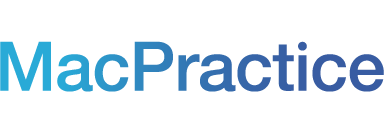Most practices run PCs using Windows–based applications. Windows has become the de facto standard for businesses, simply because it seems cheaper to use a Windows infrastructure than Mac.
But it only seems less expensive.
Using a tool like MacPractice and using Apple products for your practice gives you an edge in effectiveness, efficiency, and economy.

Reap the benefits of Apple technology
When a doctor wants to buy new computer for the office, he or she rightfully wants the most cost effective solution. So when Windows-based computers are compared to Apple computers, the winner – based on hardware price tags – appears to be the Windows computers. But that’s not the whole story. Sure, the Apple computers may initially be more expensive than the PCs, but it’s important to look at the total cost of ownership (TCO). This takes all of the variables of computer ownership into account, including: price of hardware, price of software, set up costs, recurring IT support and more. When all those factors are considered, the Apple products emerge as the clear winner.
Basic MacPractice setup is easy enough for many doctors to handle themselves, since it is largely “plug and play.” If help is needed, MacPractice has local consultants who can help with on-site visits. But the biggest cost savings will be seen each year in the form of cheaper ongoing IT support fees. Many doctors running mid-sized practices that have switched to MacPractice say that they have saved $10,000 or more each year, because the software is easy to use and doesn’t require constant babysitting by IT staff.
Make use of Mobile
Smartphones, tablets, and laptops are everywhere today, and there’s no reason that they can’t be brought in to enhance your practice.
The first place they can be used is by patients, checking in. Using a mobile app like MacPractice Check In, the patient can check him or herself in, automatically notifying the doctor, hygienist, and front desk staff of arrival. Also, this method of check-in satisfies HIPAA guidelines, because the patient only sees their own information. Next, front desk staff gives the patient an iPad so that he or she can use the MacPractice Clipboard app, ready with all the necessary forms ready for them. Since the app connects with the practice management software, the data that normally gets handwritten on a clipboard and must be keyed-in manually is automatically entered into the system.
In the treatment/exam rooms, Electronic Dental Records (EDR/EHR) are becoming more prevalent, so clinicians can use iPads to visit notes and treatment details.
In addition to the benefit of efficiency, this also shines a high-tech light on the practice.
Start a New Practice
Recent graduates are likely already users of Apple’s products, so devices like Macs, iPhones, and iPads are second nature to them. Graduates are used to these products’ ease of use, reliability, and power. MacPractice makes it possible for them to continue using these devices in every part of their new practice.
For doctors who purchase practices from another doctor, or a doctor who is simply interested in switching from a PC-based system, MacPractice’s data conversion team can extract data from on old system and migrate it to MacPractice, affordably.
Training on a new system in critically important, being the most effective way to get a new practice up and running smoothly. MacPractice’s goal is for a new client to be up and running after training is complete.
New doctors might embrace such features as MacPractice’s iPad apps, which make paperless practices possible, and even practical.
Doctors have a lot of options when it comes to practice management solutions, but a system like MacPractice – already used by 30,000 users in 4,000 offices around the US – provides a feature-rich, easy-to-use system that won’t break the bank.
